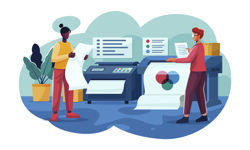According to workshop chairman, Robin Crumby, there are, broadly speaking, six online revenue models:
1. Free content sites with ad revenue (advertiser pays)
2. Premium content sites (user pays)
3. Classified sites (advertiser pays to list jobs etc)
4. Lead generation sites (free to register, publishers make money by cross selling products off the back end)
5. Retail sites (products to buy)
6. Hybrid sites (mix of user pays and advertiser pays)
Publishing pyramid
Two, broadly similar, publishing pyramids were discussed in the workshop – the Melcrum Publishing one and the Mequoda one. At the top of each were ‘high value / few customer’ products, such as research projects and consultancy and at the bottom level of the pyramid were the ‘low value / many customer’ products such as email newsletters. In between were other levels of product; reports, webinars, subscription publications, membership groups, events and training. As you climbed the pyramid, the value of the product went up and the number of customers went down. The challenge was to build from the bottom, using free content to create a permission-based email marketing database, and to then move customers up through the different levels. This meant, according to Robin Crumby, a ‘willingness to give away content, with the prospect of monetising further down the line.’
Using this pyramid model allows publishers to get much more mileage out of its content. What can start out as a premium piece of research at the top, can flow down through the pyramid, being repurposed along the way to suit different audiences, until it ends up as a ‘top ten tips’ item in a free email newsletter.
Spike the myth of free information
Euromoney is in the process of developing an electronic subscription-based repository of information for its clients. In his efforts to research, and sell, the concept, Julian Davies had to struggle hard against two widespread misconceptions about online information: firstly that it is ‘free’ and secondly that there is ‘too much’.
Is the information really free? Web users, especially in a B2B environment, need to put a cost on failed searches and long search times. If a subscription based research tool enables a subscriber to find the relevant information in 10 minutes, compare this with the fruitless hour wasted searching for it via Google. Publishers of paid-for content sites need to focus their sales pitch at this level. As for ‘too much’, the really valuable information is either on restricted access sites or, if not, will take the average searcher too long to find in any event.
Web conferencing
Investment Week’s Toby Finden-Crofts revealed how they had set up a regular, interactive web conference club. This took a debate format, chaired by an IW journalist, with three panellists – who might include a pensions specialist and reps of the sponsor. About 120 carefully targeted and extremely valuable (to the sponsor) people, (in IW’s case, discretionary fund managers) listen in and interact with the event through instant polls or by firing questions, via the chair, to the panel. Revenue is from sponsorship. There are few overheads, and all proceedings are written up and published in the next issue – nice ‘free’ topical content.
Aggregation sites
Incisive Media’s Henry Perks described the workings of their subscription website, www.baselalert.com. The site was launched in 2004 to provide alerts and news updates on the Basel II accord and risk regulation (one year sub - £380). While the site does generate some of its own content, the vast bulk of it consists of relevant material culled and repurposed from other Incisive publications. By aggregating related content, they have been able to create a highly targeted and interested audience. It is a subscription product, with minimal overheads and considerable sponsorship potential.
Converting visitors into paying customers
The Economist Intelligence Unit’s Brian Mulligan, had lots of advice:
* make it as easy as possible for people to find what they want, with the aim of getting them to where they want to be within two or three clicks.
* incentivise your customers to register, because you can always go back to a non-purchaser if you know who he is.
* highlight your latest and most popular products. Your site should not simply be a catalogue. It is, after all, a store.
* let them buy as little as they need – they will always come back for more, if you are providing them with value for money.
* avoid disappointment at all costs; if you are selling chapters, then give a word count.
* if at first you don’t succeed, keep promoting to your non buyers or at least find out why they haven’t bought.
Conclusion
Robin Crumby wrapped things up: ‘we’re not in the pioneering phase anymore; the web is now a well trodden path, and we can all benefit from the experiences and mistakes of others.’ The next phase is one of harnessing the web, and email, for publishing profit. He finished with two tips for those wanting to explore the world of online revenue models further. Firstly subscribe to the Mequoda Library (www.mequodalibrary.com – it’s not free!), and secondly read David Meerman Scott’s book, Cashing in with Content (it’s on Amazon.)
FEATURE
Online publishing: how to profit from new online revenue models
In February 2006, NEPA held a half day workshop looking at online revenue models. James Evelegh went along to listen.










